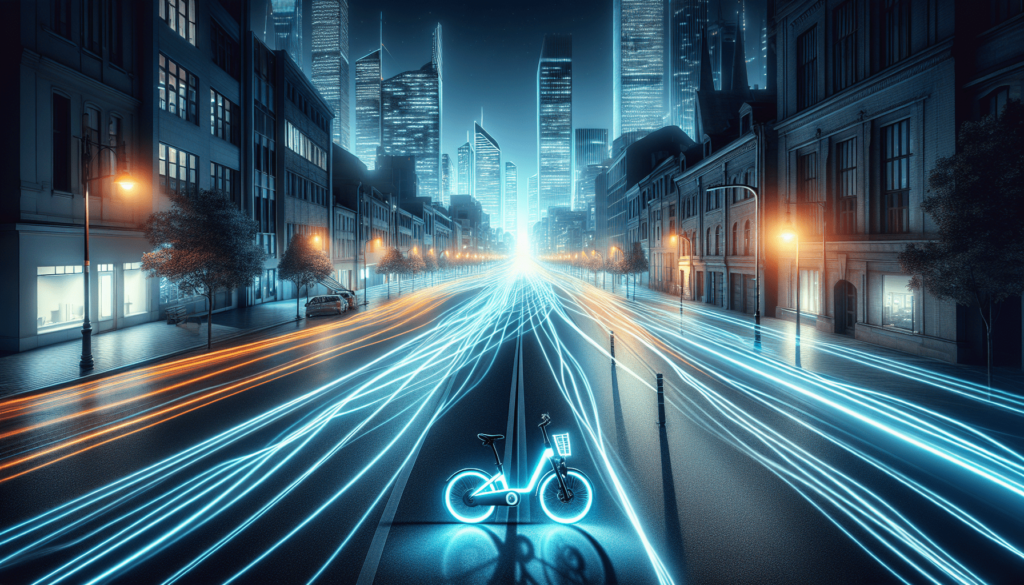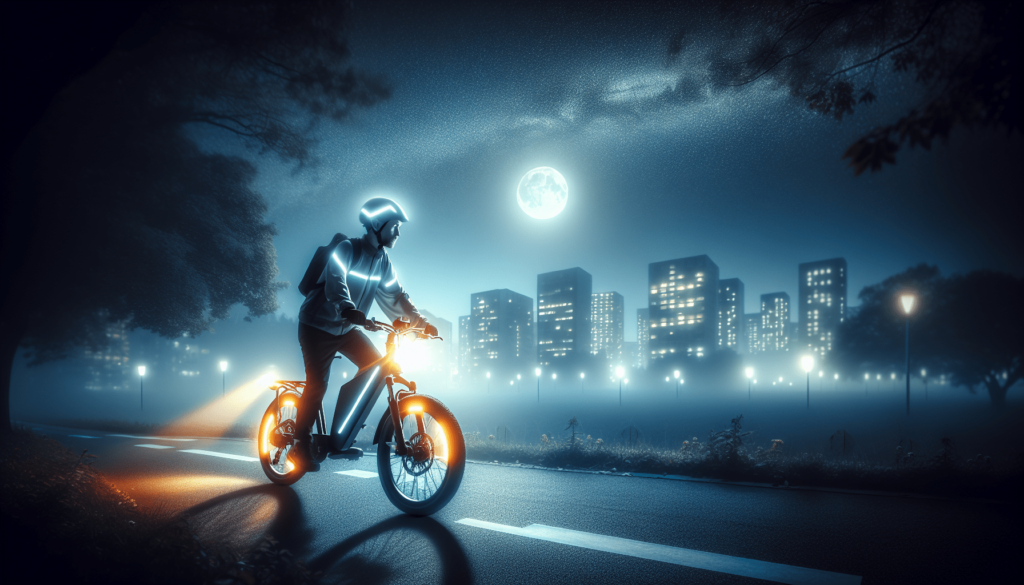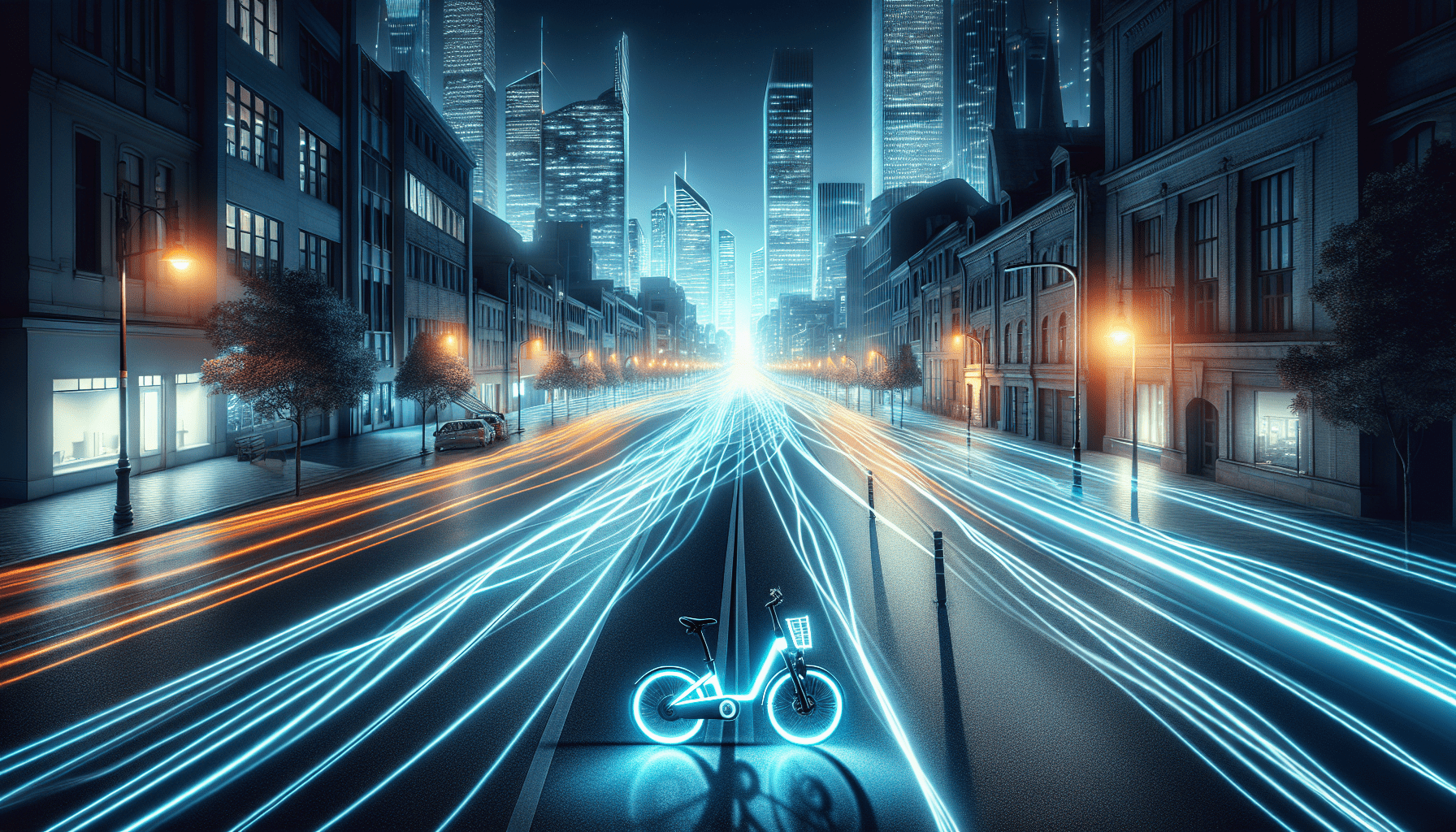Imagine cruising down a dimly lit street on a warm summer night, feeling the cool breeze against your face as you effortlessly glide on your e-bike. But wait, there’s a question that lingers in your mind – can you ride an e-bike in the dark or at night? Well, fear not! In this article, we will explore the exciting world of e-bikes and shed some light on whether it’s safe and legal to ride them in the dark or at night. So buckle up and let’s dig into the details!

Visibility and Safety
Importance of Visibility
When riding an e-bike, it is crucial to prioritize visibility to ensure your safety on the road. Being visible to other road users, including drivers and pedestrians, greatly reduces the risk of accidents. By enhancing your visibility, you give others ample time to react and adjust their behavior accordingly. This becomes even more important when riding at night or in low light conditions, as visibility can be significantly reduced.
Reflective Gear
One of the most effective ways to enhance your visibility is by wearing reflective gear. Reflective clothing, such as jackets, vests, and ankle bands, utilize retroreflective materials to reflect light back towards its source, making you more noticeable. These items are especially important when riding at night or in dimly lit areas, as they significantly increase your visibility to others.
Lights and Flashing LEDs
In addition to reflective gear, it is essential to equip your e-bike with proper lighting. Headlights and taillights are crucial for creating visibility and alerting others to your presence on the road. Headlights illuminate the path ahead, allowing you to see and be seen by oncoming traffic, while taillights make you visible from behind. using flashing LEDs on your bike or clothing can also provide an extra layer of visibility, particularly in low light conditions or when riding in areas with heavy traffic.
Legal Considerations
Local Laws and Regulations
Before riding your e-bike, familiarize yourself with the local laws and regulations regarding riding at night. Some jurisdictions may have specific rules governing the use of e-bikes during nighttime hours. It is important to know whether you need additional equipment or permits to ride in the dark and to comply with any applicable regulations.
Required Equipment
Certain jurisdictions may have specific requirements for the equipment you need on your e-bike when riding at night. This often includes the mandatory use of headlights and taillights, as well as reflectors. Failure to comply with these requirements may result in fines or other penalties. Therefore, it is essential to understand and adhere to the necessary equipment regulations in your area.
Equipment and Gear
Headlights
Headlights are a fundamental piece of equipment for riding your e-bike at night. They not only illuminate the road ahead, but they also make you visible to other road users. Make sure your headlights are in proper working order and positioned correctly to provide adequate lighting. Consider choosing a headlight that offers different brightness settings, allowing you to adjust the intensity according to the surrounding lighting conditions.
Taillights
Equally important as headlights, taillights play a crucial role in making you visible from behind. They alert drivers and pedestrians of your presence, allowing them to maintain a safe distance. It is important to choose taillights that are bright and easily noticeable, ensuring maximum visibility for those approaching from behind.
Reflectors
Reflectors are additional safety features that enhance your visibility, especially when riding at night. Install reflectors on the front, rear, and sides of your e-bike. These reflectors bounce back the light from other sources, making your bike more visible to others on the road. Reflective tape on your pedals and wheels can also improve your visibility further.
Bell or Horn
While not directly related to visibility, a bell or horn is essential for alerting pedestrians and other road users of your presence. Using a bell or horn in situations where visibility may be compromised, such as at night or in dense traffic, increases safety by reducing the chance of collisions.
Flashing LEDs
Flashing LEDs can significantly increase your visibility on the road. Attach flashing LED lights to your helmet, clothing, or bike frame to create extra visibility. These lights are especially effective when riding in low light conditions, as they catch the attention of other road users and ensure they can see you clearly.
Choosing the Right Route
Well-Lit Areas
When riding at night, it is advisable to choose well-lit routes whenever possible. Stick to roads that have adequate street lighting to improve your visibility and reduce the chance of unexpected obstacles. Well-lit areas also provide better visibility for other road users, reducing the likelihood of accidents caused by misjudgment or lack of visual cues.
Avoiding High Traffic Areas
Another factor to consider when planning your route for night riding is the traffic density. It is generally a good idea to avoid high traffic areas, especially if you are less experienced or uncomfortable riding in congested conditions. By choosing quieter roads or alternative routes, you can minimize the potential risks associated with riding at night.
Utilizing Bike Lanes
Whenever available, make use of designated bike lanes or cycling infrastructure. These dedicated lanes offer a safer environment for cyclists, providing a clear separation between motor vehicles and bikes. Bike lanes often have enhanced lighting, further improving visibility and reducing the likelihood of accidents.

Weather Conditions
Rain and Wet Surfaces
When riding an e-bike at night, it is important to consider the impact of weather conditions on visibility and safety. Rain and wet surfaces can significantly reduce visibility both for you and for other road users. Ensure your headlights and taillights are functioning properly, as they can cut through rain and mist, improving your visibility. Additionally, wearing waterproof clothing with reflective accents can enhance both safety and visibility in wet conditions.
Fog and Limited Visibility
Fog can severely limit visibility, making riding at night even more challenging. If confronted with foggy conditions, it is crucial to exercise caution and adjust your speed accordingly. Use your headlights and taillights to increase your visibility and consider using fog lights or additional reflective gear to further enhance your presence on the road. If the fog becomes too thick and impairs your ability to see or be seen, it is advisable to seek alternative transportation options.
Riding Skills and Techniques
Maintaining Speed Control
Maintaining proper control of your speed is essential when riding an e-bike, especially at night. Reduced visibility may make it more difficult to anticipate obstacles or sudden changes in the roadway. Slowing down and maintaining a reasonable and manageable speed allows you to react timely and safely to any unexpected situations that may arise. Remember, riding at a speed suitable for the conditions is paramount for your safety.
Using Hand Signals
Proper signaling is critical for communicating your intentions to other road users, especially at night when visibility is limited. Always use clear and distinct hand signals when turning or changing lanes. Signaling your actions in advance allows drivers and pedestrians to anticipate your movements, decreasing the potential for collisions.
Keeping a Safe Distance
Maintaining a safe distance from other road users is crucial for your safety, particularly at night when visibility may be compromised. Keep a safe following distance when riding behind other vehicles, allowing ample time to react to sudden stops or unexpected maneuvers. Additionally, avoid riding too closely to parked cars to reduce the risk of opening doors or other potential hazards.
Visibility Tips for Other Road Users
Wearing Bright Clothing
Enhance your visibility to other road users by wearing bright, contrasting clothing. Choose colors such as fluorescent yellow, orange, or green, which are highly visible, even in low light conditions. By making yourself more noticeable, you increase the chances of being seen by drivers and pedestrians, reducing the risk of accidents.
Avoiding Distracted Riding
Avoiding distractions while riding, such as using mobile phones or listening to loud music, improves your overall awareness and visibility on the road. Paying full attention to your surroundings allows you to react to potential hazards promptly. Eliminating distractions not only increases your safety but also ensures that you can easily be seen by other road users.
Maintaining and Inspecting Your E-bike
Regular Maintenance
To ensure your e-bike is in optimal condition for night riding, regular maintenance is crucial. Conduct routine checks of your brakes, tires, and gears to ensure they are functioning properly. Properly lubricate the chain and check for any loose or damaged components. Regular maintenance helps prevent unexpected breakdowns or mechanical failures that could compromise your safety.
Check the Lights and Reflectors
Before riding at night, always check that your e-bike lights and reflectors are in good working order. Ensure that both the front and rear lights are functioning correctly and that reflectors are clean and undamaged. It is also advisable to carry spare batteries or a backup lighting system in case of any failures during your ride.
Inspect Battery and Power Levels
An essential aspect of riding an e-bike at night is to ensure that your battery has sufficient power. Check the battery level before embarking on your ride and top it up if necessary. Riding with a charged battery reduces the risk of losing power during your journey, which could leave you in a precarious situation in low light conditions.
Riding in Groups or with Others
Stay Close and Visible
When riding in a group or with others, it is essential to stay close and visible to ensure the safety of everyone involved. Maintain a reasonable distance between bikes, allowing for clear communication and reaction time. Ensure that each rider has appropriate lighting and reflective gear to maximize visibility, especially when riding at night.
Use Proper Communication
Clear communication is key when riding with others, and this becomes even more critical at night. Use hand signals, verbal cues, or electronic communication devices, such as bike-mounted walkie-talkies, to ensure everyone is aware of upcoming turns, stops, or changes in the route. Effective communication helps maintain group cohesion and enhances safety on the road.
Conclusion
Riding Responsibly
Riding an e-bike in the dark or at night requires extra caution and responsibility. Always prioritize safety by wearing reflective gear, equipping your bike with proper lighting, and adhering to local laws and regulations. By being visible to other road users, you significantly reduce the risk of accidents and ensure a safe riding experience.
Ensuring Your Safety
Taking the necessary precautions to enhance your visibility and ensure your safety is paramount when riding an e-bike in the dark or at night. From equipping your bike with adequate lighting to choosing well-lit routes, every decision you make should prioritize your safety and that of others on the road. By maintaining your bike, employing proper riding techniques, and communicating effectively, you can enjoy the benefits of e-biking while minimizing the risks associated with nighttime riding. Ride responsibly, stay visible, and enjoy your e-biking adventures with confidence!

